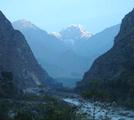 今年2月一個氣溫不到攝氏10度的晴晨,一個由5名研究員組成的小隊,在被雪覆蓋的地表隨意但卻有系統的行走,試圖找尋雪豹的蹤跡。突然間其中一位生物學家在雪地上發現了獸跡。凱斯博士(Randall Kyes)宣稱:「那是雪豹的腳印」。凱斯博士在西雅圖的華盛頓大學任副教授,他率領雪豹研究團隊在尼泊爾藍塘國家公園進行兩週的調查研究。
今年2月一個氣溫不到攝氏10度的晴晨,一個由5名研究員組成的小隊,在被雪覆蓋的地表隨意但卻有系統的行走,試圖找尋雪豹的蹤跡。突然間其中一位生物學家在雪地上發現了獸跡。凱斯博士(Randall Kyes)宣稱:「那是雪豹的腳印」。凱斯博士在西雅圖的華盛頓大學任副教授,他率領雪豹研究團隊在尼泊爾藍塘國家公園進行兩週的調查研究。
根據收集到的證據分析,科學家證實藍塘國家公園雪豹的數量至少有5到10隻。這也是首次以科學方式確認該國家公園境內的雪豹數量。
目前,估計約有4,510到7,350隻雪豹存活在全世界各地。雪豹的總棲息地在12個國家大約有183萬平方公里。
雪豹和人類間的衝突,是威脅該物種生存的主要因素──因為雪豹會殺死綿羊、山羊、馬和小牛。而雪豹棲息地惡化的原因則是源於放牧壓力──特別是因30年前西藏邊界封閉後。
偷獵者也因為牠的骨頭和毛皮,瞄準這個喜馬拉雅山脈的旗標物種。全球暖化可能也對雪豹生存帶來負面衝擊,因為牠們只能生活在林木線(treeline)以上和永久雪線以下。
「因為氣候改變和雪線內縮,雪豹得遷徙到更高處──植物和可捕食的物種也較少。」尼泊爾川布萬大學副教授暨生物學家Mukesh Chalise博士表示。為了保護雪豹,尼泊爾政府正實行一項2003年間發起的行動計劃,並與世界自然基金會(WWF)尼泊爾專案小組和馬亨德拉國王自然信託保護(KMTNC)共同做合作。
 The mercury is below 10 degrees Celsius on this shiny morning in February 2006. A team of five researchers is exploring for traces of snow leopards. They walk randomly, yet systematically, on the snow-blanketed terrain. Suddenly, one of the biologists sees a series of pugmarks on the snow. "The pugmarks are of snow leopard," declares Dr. Randall Kyes. Associate professor at the University of Washington in Seattle, Dr. Kyes is the team leader of this two week long snow leopard research mission in Nepal's Langtang National Park.
The mercury is below 10 degrees Celsius on this shiny morning in February 2006. A team of five researchers is exploring for traces of snow leopards. They walk randomly, yet systematically, on the snow-blanketed terrain. Suddenly, one of the biologists sees a series of pugmarks on the snow. "The pugmarks are of snow leopard," declares Dr. Randall Kyes. Associate professor at the University of Washington in Seattle, Dr. Kyes is the team leader of this two week long snow leopard research mission in Nepal's Langtang National Park.
On the basis of evidence collected, the scientists have confirmed that the population of snow leopards, Uncia uncia, in Langtang National Park is at least five to 10 individuals. This is the first time that a snow leopard population in Langtang has been scientifically confirmed.
It is estimated that there are about 4,510 to 7,350 snow leopards remaining anywhere in the world. The total potential snow leopard habitat is about 1.83 million square kilometers in 12 snow leopard range countries.
The snow leopard-human conflict is one of the main threats to the species' survival because snow leopards are known to kill sheep, goats, horses, and yak calves. Degradation of snow leopard habitat continues due to year-round grazing pressure following the closure of the Tibetan border some 30 years ago.
Poachers are also targeting this flagship species of the Himalayas for its bones and fur. Global warming may also have a negative impact on the survival of snow leopards because they live just above the treeline and below the permanent snow line.
"Because of climate change and decreasing snow line, snow leopards are moving higher where vegetation is scarcer and its prey species, which depend on vegetation, are absent," says biologist Dr. Mukesh Chalise, an associate professor at Tribhuwan University in Nepal. To conserve the snow leopard the government of Nepal has been implementing an Action Plan that was prepared in 2003 in collaboration with World Wildlife Fund (WWF) Nepal Program and King Mahendra Trust for Nature Conservation (KMTNC).





